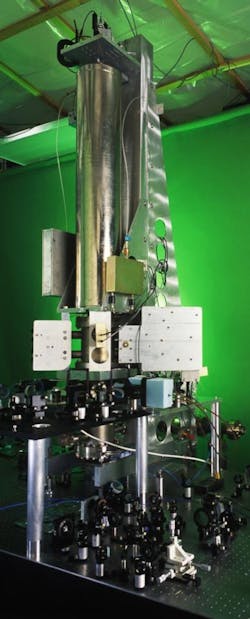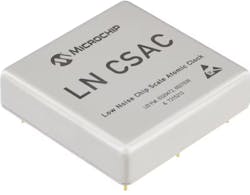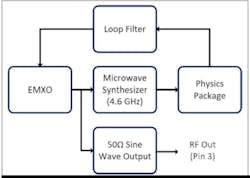Next-Gen Chip-Scale Atomic Clock: Thin is In, Noise is Out
What you’ll learn:
- Where and why tiny, portable, atomic clocks and their precision are needed.
- How atomic clocks are no longer room- or box-size arrangements.
- The size, power, and other metrics of a latest-generation chip-scale atomic clock.
The term “atomic clock” often conjures up images of room-size systems such as the master clocks at NIST (Fig. 1) with an uncertainty approaching 1 × 10-16 (as work continues in attempts to reach one and even two order of magnitudes improvement!) or even box/rack-size units such as those offered by test and measurement vendors or packed into GPS satellites.
However, there are far smaller alternatives, albeit with somewhat less precision than the larger and more power-hungry counterparts. Several years ago, Microchip Technology introduced a chip-scale atomic clock (CSAC) that used a range of innovative technologies to provide a PCB-mounted device.
Now, the company has a new generation of that device family. Its SA65-LN low-noise chip-scale atomic clock (LN-CSAC) features a lower profile height and can operate over a wider temperature range, enabling low phase noise and atomic-clock stability in demanding conditions (Fig. 2).
The new design targets aerospace and defense mission-critical applications such as mobile radar, dismounted radios, dismounted IED jamming systems, autonomous sensor networks, and unmanned vehicles due to its compact size, low power consumption, and high precision. In applications, precise clocks are needed for functions such as system synchronization and GPS-denied navigation.
[By the way, if you were puzzled or worried by the news that “Microchip” was going out of business—not at all! Electronic Design Content Director Bill Wong explains the details of this case of an unrelated company with a similar name that “microchips” pets, which is now running into financial difficulty, see “Yes, Virginia, Microchip is Still in Business”.]
Leveraging EXMO Technology
The design is based on Microchip’s unique Evacuated Miniature Crystal Oscillator (EMXO) technology that’s integrated into the CSAC, enabling the model SA65-LN to offer a reduced profile height of half an inch (a good fit for narrow, VPX-style chassis), while maintaining power consumption below 295 mW (3.3-V supply). Operating within a wider temperature range of −40 to +80°C (a −10 to +70°C version is also offered), the LN-CSAC is designed to maintain its frequency and phase stability in extreme conditions for enhanced reliability.
The LN-CSAC combines the benefits of a crystal oscillator and an atomic clock in a single compact device; no external phase-locked loop (PLL) is needed (Fig. 3). The temperature stability of the EMXO is improved by the CSAC. This is especially important when the LN-CSAC is in free-running “holdover” mode and can’t be calibrated to a primary reference clock.
The EMXO offers low-phase noise at 10 Hz, less than −120 dBc/Hz, and Allan Deviation (ADEV) stability better than 3 × 10-11 with a one-second averaging time. The atomic clock provides initial accuracy of ±0.5 parts per billion (ppb), low frequency-drift performance under 0.9 ppb/month, and maximum temperature-induced errors below ±0.3 ppb.
(Allan Deviation, also called Allan Variance, measures the fractional frequency uncertainty of the clock output frequency when averaged for a specific time period; it’s an important figure-of-merit for clocks, see References.)
Overall package size is 2 × 2 × 0.5 in. (51 × 51 × 12.7 mm). The device meets multiple MIL standards, including those related to vibration and shock, humidity, and EMI.
It includes a 3-V CMOS RS-232 serial interface (yes, it’s still in use after all these years) for monitoring, control, and calibration. This interface works in conjunction with the company’s Clockstudio software tool.
The Clockstudio graphical user interface (GUI) helps designers quickly toggle among the clock’s features and plot their operating parameters, as well as its responses to various environmental conditions.
If the three-page datasheet piques your interest and you want to know more about the LN-CSAC, check out the 50-page User Manual for more details and insight.
Note that classic atomic clocks may not be the only precision-timing option and could soon see some disruptive competition. University researchers are investigating precision clocks based on the terahertz-range resonance of a molecule and fabricated as ICs, rather than using principles and construction of classic atomic clocks.
References
Wikipedia, “Allan variance.”
National Institute for Standards and Technology, “Analysis of Time Domain Data” (Allan Deviation).
National Institute for Standards and Technology, “NIST-F1 Cesium Fountain Atomic Clock.”
EE World Online, “The PC-board atomic clock, Part 2: The CSAC design.”
EE World Online, “The PC-board atomic clock, Part 3: The CSAC cesium physics cell.”
About the Author

Bill Schweber
Contributing Editor
Bill Schweber is an electronics engineer who has written three textbooks on electronic communications systems, as well as hundreds of technical articles, opinion columns, and product features. In past roles, he worked as a technical website manager for multiple topic-specific sites for EE Times, as well as both the Executive Editor and Analog Editor at EDN.
At Analog Devices Inc., Bill was in marketing communications (public relations). As a result, he has been on both sides of the technical PR function, presenting company products, stories, and messages to the media and also as the recipient of these.
Prior to the MarCom role at Analog, Bill was associate editor of their respected technical journal and worked in their product marketing and applications engineering groups. Before those roles, he was at Instron Corp., doing hands-on analog- and power-circuit design and systems integration for materials-testing machine controls.
Bill has an MSEE (Univ. of Mass) and BSEE (Columbia Univ.), is a Registered Professional Engineer, and holds an Advanced Class amateur radio license. He has also planned, written, and presented online courses on a variety of engineering topics, including MOSFET basics, ADC selection, and driving LEDs.



